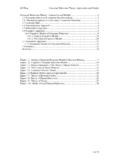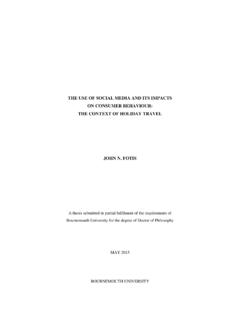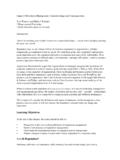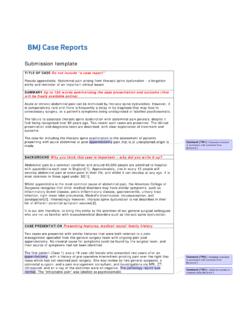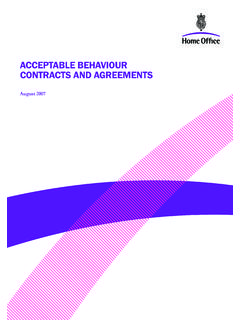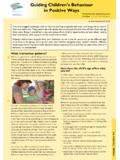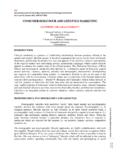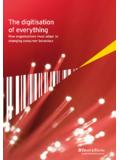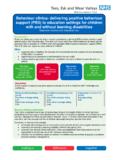Transcription of Jeff Bray Consumer Behaviour Theory: Approaches …
1 Jeff Bray Consumer Behaviour Theory: Approaches and Models Consumer Behaviour Theory: Approaches and Consumer Behaviour & Consumer decision Theoretical Approaches to the study of Consumer Economic Psychodynamic Behaviourist Cognitive Cognitive Models of Consumer Analytic Cognitive Prescriptive Cognitive Humanistic Approach ..25 Humanistic Models of Consumer Figure : Stimulus-Organism-Response Model of Decision Figure : Cognitive Consumer Behaviour Figure : Major components of the Theory of Buyer Figure : The Theory of Buyer Figure : Consumer Decision Figure : Fishbein Model expressed Figure : Theory of Reasoned Figure : Theory of Planned Figure : Theory of Figure : Model of Goal-Directed 1 of 33 Jeff Bray Consumer Behaviour Theory: Approaches and Models Consumer Behaviour Theory.
2 Approaches and Models Consumer Behaviour & Consumer decision making Consumer decision making has long been of interest to researchers. Beginning about 300 years ago early economists, led by Nicholas Bernoulli, John von Neumann and Oskar Morgenstern, started to examine the basis of Consumer decision making (Richarme 2007). This early work approached the topic from an economic perspective, and focused solely on the act of purchase (Loudon ANDD ella Bitta 1993). The most prevalent model from this perspective is Utility Theory which proposes that consumers make choices based on the expected outcomes of their decisions.
3 Consumers are viewed as rational decision makers who are only concerned with self interest (Schiffman ANDK anuk 2007, Zinkhan 1992). Where utility theory views the Consumer as a rational economic man (Zinkhan 1992), contemporary research on Consumer Behaviour considers a wide range of factors influencing the Consumer , and acknowledges a broad range of consumption activities beyond purchasing. These activities commonly include; need recognition, information search, evaluation of alternatives, the building of purchase intention, the act of purchasing, consumption and finally disposal.
4 This more complete view of Consumer Behaviour has evolved through a number of discernable stages over the past century in light of new research methodologies and paradigmatic Approaches being adopted. While this evolution has been continuous, it is only since the 1950 s that the notion of Consumer Behaviour has responded to the conception and growth of modern marketing to encompass the more holistic range of activities that impact upon the Consumer decision (Blackwell,Miniard et al. 2001). This is evident in contemporary definitions of Consumer Behaviour : 2 of 33 Jeff Bray Consumer Behaviour Theory: Approaches and Models Consumer is the study of the processes involved when individuals or groups select, purchase, use or dispose of products, services, ideas or experiences to satisfy needs and desires.
5 (Solomon,Bamossy et al. 2006, p6). (Schiffman ANDK anuk 2007) take a similar approach in defining Consumer Behaviour : the behavior that consumers display in searching for, purchasing, using, evaluating, and disposing of products and services that they expect will satisfy their needs ( ). While most contemporary definitions of Consumer Behaviour are similar in scope, section will identify and discuss the differing psychological Approaches that have been applied to research in this area. Theoretical Approaches to the study of Consumer Behaviour A number of different Approaches have been adopted in the study of decision making, drawing on differing traditions of psychology.
6 Writers suggest different typological classifications of these works with five major Approaches emerging. Each of these five Approaches posit alternate models of man, and emphasise the need to examine quite different variables (Foxall 1990); they will briefly be introduced in turn. Economic Man Psychodynamic Behaviourist Cognitive Humanistic 3 of 33 Jeff Bray Consumer Behaviour Theory: Approaches and Models Economic Man As identified in section , early research regarded man as entirely rational and self interested, making decisions based upon the ability to maximise utility whilst expending the minimum effort.
7 While work in this area began around 300 years ago (Richarme 2007), the term economic man (or even Homo economicus (Persky 1995)) was first used in the late 19th century (Persky 1995) at the start of more sustained research in the area. In order to behave rationally in the economic sense, as this approach suggests, a Consumer would have to be aware of all the available consumption options, be capable of correctly rating each alternative and be available to select the optimum course of action (Schiffman ANDK anuk 2007). These steps are no longer seen to be a realistic account of human decision making, as consumers rarely have adequate information, motivation or time to make such a perfect decision and are often acted upon by less rational influences such as social relationships and values (Simon 1997).
8 Furthermore, individuals are often described as seeking satisfactory rather than optimum choices, as highlighted by Herbert Simons Satisficing Theory (Simon 1997), or Kahneman and Tversky s Prospect Theory (Kahneman ANDT versky 1979) which embrace bounded rationality (Simon 1991). Psychodynamic Approach The psychodynamic tradition within psychology is widely attributed to the work of Sigmund Freud (1856-1939) (Stewart 1994). This view posits that Behaviour is subject to biological influence through instinctive forces or drives which act outside of conscious thought (Arnold,Robertson et al.)
9 1991). While Freud identified three facets of the psyche, namely the Id, the Ego and the Superego (Freud 1923), other theorists working within this tradition, most notably Jung, identified different drives (Ribeaux ANDP oppleton 1978). The key tenet of the psychodynamic approach is that Behaviour is determined by biological drives, rather than individual cognition, or environmental stimuli. 4 of 33 Jeff Bray Consumer Behaviour Theory: Approaches and Models Behaviourist Approach In 1920 John B. Watson published a landmark study into Behaviour which became known as Little Albert (Watson ANDR ayner 1920).
10 This study involved teaching a small child (Albert) to fear otherwise benign objects through repeated pairing with loud noises. The study proved that Behaviour can be learned by external events and thus largely discredited the Psychodynamic approach that was predominant at the time. Essentially Behaviourism is a family of philosophies stating that Behaviour is explained by external events, and that all things that organisms do, including actions, thoughts and feelings can be regarded as behaviours . The causation of Behaviour is attributed to factors external to the individual.
